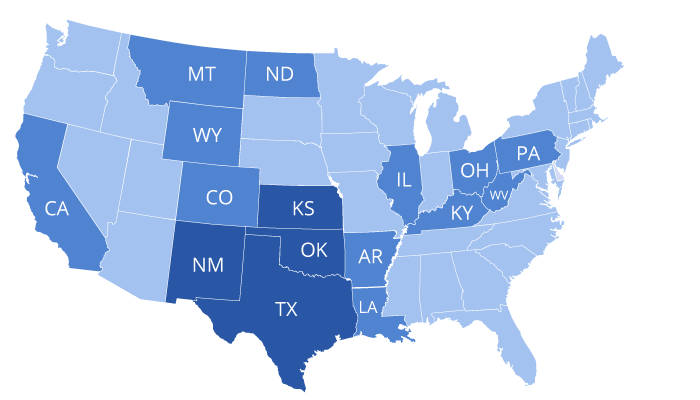How to Read Oil & Gas
Royalty Statements
Request an Offer:
How Do You Read a Royalty Statement?
Once your mineral rights are leased and producing, you’ll most likely receive monthly royalty checks from the company operating the well. Royalty statements vary from operator to operator, but all statements contain the same basic accounting information related to how much the oil or gas well produced, the commodity price, your interest, and your share of the revenue. Let’s break it down and look at each section.
Royalty Statement Example
This example comes from a small well in West Texas. Each operator has a slightly different royalty statement layout, but most contain the same basic information.


What is in a Royalty Statement?
There are three parts to a royalty statement:
- Basic Info
- Whole Well Figures (gross)
- Owner Figures (net)
Basic Information:
On each royalty statement, you’ll find basic information about the operator, the oil & gas well, and the owner.
Whole Well Figures:
This section represents the production, taxes, deductions and gross revenue for the entire well. This figure will be divided among all the interest owners.
Owner Figures:
This section represents the owner’s portion of the oil & gas volume, taxes, deductions, and net revenue.

Property
The property refers to the producing well. This line lists a combination of the identification number, lease name, well name, county, state, and other identifying information. You can use this information to verify the well’s production with your state regulatory agency – or just simply look and see where, on the map, your well is located.


Production Date
Production figures are reported monthly and listed by month and year on your royalty statement. In the above example, 1118 refers to November of 2018, while 1218 refers to December 2018. Oil and gas royalties are usually paid two or three months post-production.


Interest Type
While a vast majority of the owners have royalty interest, there are several types of interest, including Royalty Interest, Working Interest, Overriding Royalty Interest (ORRI) and Non-Participating Royalty Interest. Confused about interest types? We have a guide on types of mineral rights.


Product Code
Each product produced by a well is reported as a separate line item. It’s common to see oil, natural gas, condensate, and other production products (i.e., helium, sulfur, etc.).


Unit Price
The unit price is the sales price per unit of oil ($/barrel), gas ($/MCF), and other products ($/gallon). This is a difficult number to verify because the rates change from day-to-day and by type and quality of the oil. You can look up the average monthly price to make sure looks reasonable. The example well is located in west Texas, so we would look at the West Texas Crude Price by Month and the Natural Gas Price by Month. Your minerals might be from another region or even another state.


Owner Decimal Interest
This column represents your interest in the well. Most wells have thousands of fractional owners, with a majority owning a very small fraction of the interest. Your decimal interest will be multiplied by the gross volume, tax, and deductions to determine your net revenue.
Net Revenue = (gross volume * decimal interest) – (tax + deductions)


Gross Volume
The gross volume is the total volume (of oil, gas, etc.) that was produced that month. This could vary from month to month, but over all, will decline in time. Production volumes can be verified with the state regulatory agency.


Production Tax
Each state is responsible for taxing oil and gas production. The largest tax is usually severance tax, based on the volume or value of the product. Other taxes might include conservation, oil field cleanup, and emergency fund taxes. Each well owner is responsible for their portion of the taxes.


Other Deductions
Raw crude oil and natural gas are rarely marketable without processing. Gathering and treating are common crude oil deductions, while compression, dehydration, gathering, processing, and treating are common deductions for natural gas.


Net Revenue
Net revenue for the entire well is derived by multiplying the gross volume times the cost and subtracting gross taxes and gross deductions.
Net Revenue = (price * gross volume) – (taxes + deductions)


Owner’s Gross Revenue
This column represents the owner’s share well’s revenue. It is derived by multiplying the owner’s volume by the price.
Owner’s gross revenue = owner’s volume * price


Owner’s Production Tax
This column represents the owner’s share of the production taxes. It is derived by multiplying the interest by the gross tax.
Owner’s portion of taxes = owner’s interest * gross tax


Owner’s Other Deductions
This column represents the owner’s share of the other deductions. It is derived by multiplying the owner’s interest by the gross deductions.
Owner’s portion other deductions = owner’s interest * gross deductions


Owner’s Net Revenue
This column represents the owner’s revenue. It is derived by subtracting the owner’s portion of taxes and deductions from the owner’s gross revenue.
Owner’s net revenue = owner’s gross revenue – owner’s portion of taxes – owners portion of deductions

Where We Buy Mineral Rights
We buy both producing and non-producing minerals in all oil and gas states. However, we are especially interested in Texas and Kansas mineral rights.
|
We even buy minerals in more obscure states, such as Michigan and Illinois, which produce a very little oil and gas compared to other states.

How We Value Mineral Rights
There are many factors that play into the value of mineral rights. These include location, producing vs. non-producing properties, current oil and gas prices, well production figures, lease terms, and even the operator of the well or wells. We also look at the risks of buying and owning minerals that you are interested in selling.
Location
Minerals in the hottest shale plays are more valuable than those in older fields with conventional wells.
Producing vs. Non-Producing
Producing minerals are often worth more than non-producing minerals because they are generating revenue.
Oil & Gas Prices
When oil and gas prices drop, revenue drops, and sometimes operators are unable to continue operating the well.
Production
Highly productive wells (and off-set wells) can increase the value of your minerals.
Lease Terms
Favorable lease terms (such as a 25% royalty reservation) positively impact the value of the leased minerals.
Operator
A small number of operators are unethical, and their reputation automatically devalues your minerals.
Why Sell?
Why People Sell Their Mineral Rights
I am putting my affairs in order. I don’t want to burden my kids with the hassle of transferring ownership and managing small mineral rights. When my sister passed away, my niece and nephew had to hire an attorney to help them with the minerals. I don’t want my kids to go through that.
I inherited my mineral rights so they were sentimental, but I don’t really want to bother with managing them and filing extra tax returns. I decided to sell and use the money as a down payment on my house.
I had no idea how fast the oil production would decline. My checks are only 20% of what they were a few years ago. I should have sold my mineral rights when the wells were brand new and still generating huge royalties.
My oil wells have been producing for decades and the reserves are almost depleted. Once the wells are plugged, the value will be significantly lower. I’d rather cash out now.
I inherited mineral rights, but don’t want to be involved with fracking and fossil fuels. I would prefer to support renewable energy and do my part to reverse climate change.
